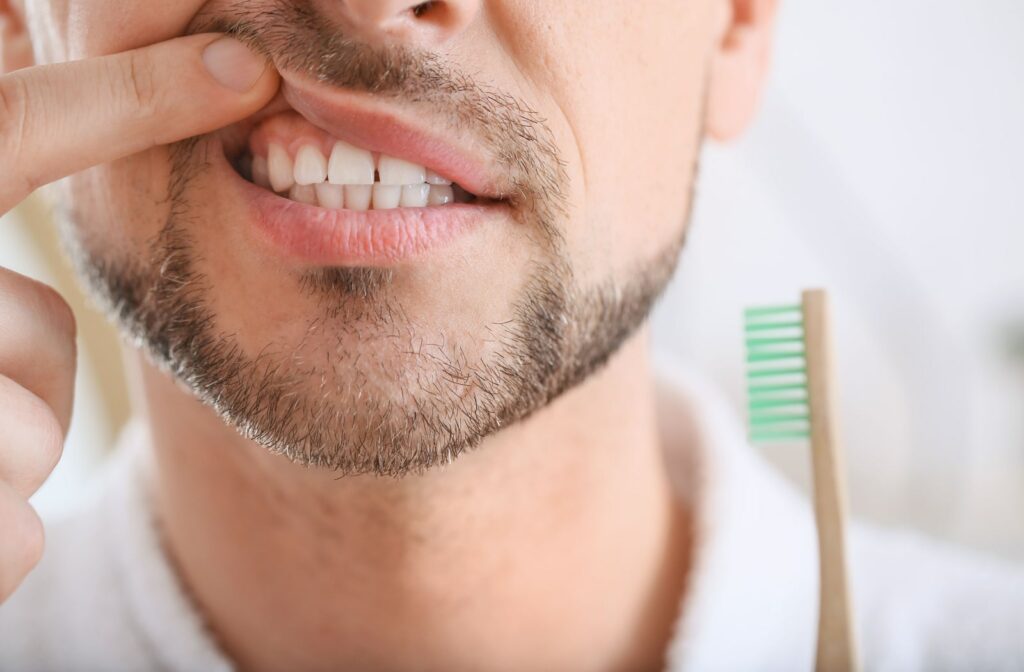Your best defense against gum disease is regular brushing and flossing your teeth, as well as having regular appointments for dental exams and cleanings to remove tartar buildup and check for gum disease.
The good news is that if caught early enough, gum disease can be reversible, but eventually, without thorough dental hygiene practices, it can become irreversible. If not caught in time, your teeth may become loose, and you may need to have your teeth extracted.
However, with regular dental hygiene and cleanings, you can reduce the effects of gum disease, such as bloody gums and bad breath, and keep your gums healthy.
What Is Gum Disease?
Periodontal (gum) disease is one of the most common dental issues adults face in Canada. The chance of getting it increases with age, with 70.1% of adults 65 years and older experiencing periodontal disease.
Gum disease is one of the most common dental problems adults face, but it can begin at any age. It often develops slowly and without causing pain, leading some people to miss the early signs.
What Are the Signs of Gum Disease?
If you don’t notice any signs until the disease is serious, you may be in danger of losing teeth. That’s why regular checkups with a dentist are imperative for your dental health.
Gum disease usually begins as gingivitis before progressing to periodontal disease. However, if caught in the early stages, it can be reversible with effort on your part and the help of your dental team.
Symptoms include:
- Pain in the gums
- Pain while chewing
- Gums changing color
- Chronically bad breath
- Red, swollen, and puffy gums
- Blood on your toothbrush or floss
- Gums pulling away from teeth

Gingivitis
Gum disease can also be called gingivitis (gum inflammation) in its early stages. It usually presents as red, swollen, and bleeding gums around the base of the teeth. You may feel pain when you floss or have a bad or metallic taste in your mouth.
Gingivitis is caused by plaque buildup accumulating on your teeth where bacteria thrive. Regular brushing and flossing can remove this buildup before it turns into tartar (or calculus).
If the buildup appears below the gum line, it’s known as subgingival calculus. Above the gum line, it’s called supragingival calculus.
However, if the plaque is left to fester, tartar hardens. Tartar cannot be removed by flossing and brushing and needs to be removed by a dental hygienist.
It’s essential to keep your dental hygiene routine consistent to reduce the risk of developing periodontitis.
Periodontal Disease
The term periodontal disease is also referring to gum disease but in a more severe state. Periodontal disease is an infection of the tissues that hold your teeth in place. In time, it can cause loosening of teeth, sensitive teeth, receding and sore gums, and bad breath. It can even cause abscesses.
When gums are inflamed, they tend to pull away from the tooth base. This causes gaps to form between the teeth and the gums, known as periodontal pockets. Your teeth may look like they are longer, as well.
As the condition advances, periodontitis can cause teeth to shift. They may start feeling loose and wobble or even hurt when you chew.
The bone around the tooth also degrades with periodontitis, causing further tooth loss and periodontal pockets that can harbor bacteria. This is why bad breath is one of the primary symptoms.
The deeper the gum pocket, the further the bacterial plaque can spread down toward the bottom of the root of the tooth. If it gets worse, it may also attack and break down the jawbone around the teeth. This can expose a part of the roots of the teeth.
When it gets to this point, periodontitis is irreversible. Your gums will not reproduce themselves, nor will the bone loss.
However, periodontitis progresses in episodes. You may experience short phases where soft tissue is destroyed. Then longer periods may occur where the disease doesn’t progress or where the tissue even recovers a bit. But periodontitis doesn’t go away again on its own.
Diagnosing Periodontal Disease
There are 3 primary ways for your dentist to check for periodontal disease.
- The first is an examination of the gums for inflammation. They may use a miniature ruler called a periodontal probe to measure the pockets around the teeth. These pockets should be at most 3 millimeters. Any deeper (up to a centimeter or more) can indicate periodontal disease.
- Your dentist will perform a medical history survey and ask about past and current health issues. Certain conditions like smoking and diabetes can contribute to gum disease.
- Your dental hygienist will take images of the mouth, specifically where the teeth connect to the gums. They will look for any bone loss caused by gum disease.
Treatment for Gingivitis & Periodontal Disease in Bond Head
The best treatment for gum disease is prevention. It’s important to brush your teeth at least twice a day and floss at least once. Use antiseptic mouthwash to reach areas that your toothbrush may not easily clean.You should have 2 exams and dental cleanings with your dentist a year.
Book an appointment today for a full cleaning and exam with your dental care team at Hill Top Dental Centre. Together we can reduce the risk of gum disease, resolve early symptoms, and keep your mouth healthy.



